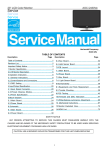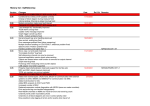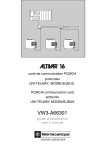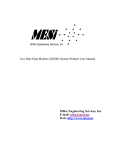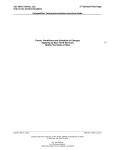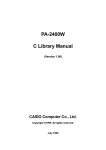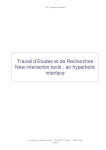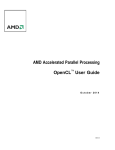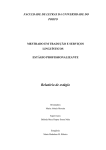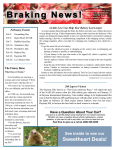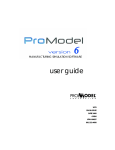Download View/Open - Oregon State University
Transcript
AN ABSTRACT OF THE THESIS OF
Adam W. Montville for the degree of Master of Science in Electrical and
Computer Engineering presented on May 21, 2003.
Title: Random Number Generation on Handheld Devices for Cryptographic
Applications
Abstract Approved:
Redacted for Privacy
Random number generation is important in many fields today. It is
particularly important in the field of cryptography when generating nonce
values, cryptographic keys, and other data required in many cryptographic
applications. The proliferation of small, handheld devices that are typically
connected to large networks via a wireless connection requires stringent
security. Because it may be easier to attack a pseudorandom number
generator than to attack a particular cryptosystem, it is important that the
generation of random numbers on handheld devices be as secure as possible.
In order for the random number generator to provide good, secure "random"
data, it must first be seeded by a value that, itself, possesses the qualities of a
good random sequence. This paper explores several potential seed sources
that are available on many current handheld devices.
© Copyright by Adam W. Montville
May 21, 2003
All Rights Reserved
Random Number Generation on llandheld Devices for Cryptographic
Applications
by
Adam W. Montville
A THESIS
submitted to
Oregon State University
in partial fulfillment of
the requirements for
the degree of
Master of Science
Presented May 21, 2003
Commencement June 2004
Master of Science thesis of Adam W. Montville presented on May 21, 2003.
APPROVED:
Redacted for Privacy
Major Professor, representing
Computer Engineering
Redacted for Privacy
Director of School of Electrical Engineejing and Computer Science
Redacted for Privacy
Dean of Graduate School
I understand that my thesis will become part of the permanent collection of
Oregon State University libraries. My signature below authorizes release of
my thesis to any reader upon request.
Redacted for Privacy
Adam W. Montville, Author
ACKNOWLEDGEMENTS
First, I thank God for providing me with the determination, perseverence,
and will to complete this thesis. I also thank my Major Professor, Dr. Cetin
K. Koc, for his guidance and helpful criticism throughout the research of this
topic. In addition, this work could not have been completed, if it were not for
my future wife, Virginia. Without her, none of this would have been possible.
My gratitude is not complete without thanking my father, who always offered
his assistance in proofing and mastering the English language. Finally, I
thank Daniel Montville for loaning me hardware test equipment - it may have
been old, but it worked!
To those who should have been named, but weren't, please forgive my
forgetfulness and know that I appreciate all those who lent a helping hand to
my research, whether directly or indirectly, including you.
TABLE OF CONTENTS
1.
2.
3.
4.
5.
6.
INTRODUCTION ................................................................
1
Background ............................................................................................... 4
2.1.
Sources of Randomness .................................................................... 4
2.2.
Handheld Devices ............................................................................. 6
Materials and Methods .............................................................................. 7
3.1.
TheSeedGoal ................................................................................... 7
3.2.
Random Bit Collection Source ......................................................... 7
3.3.
Handheld Implementation Platform .................................................. 8
3.4.
Audio Data Collection .................................................................... 10
3.5.
Test Method .................................................................................... 12
3.6.
Quantity of Collected Data ............................................................. 16
Results ..................................................................................................... 17
4.1.
Entropy Estimation ......................................................................... 17
4.2.
Arithmetic Mean ............................................................................. 19
4.3.
Monte Carlo Estimation of Pi ......................................................... 20
4.4.
Serial Correlation............................................................................ 22
Discussion ............................................................................................... 24
5.1.
Analysis of Audio Sampling ........................................................... 24
5.2.
Analysis of Touchscreen Sampling ................................................ 25
5.3.
Chi-Square Distribution Analysis ................................................... 27
Conclusion .............................................................................................. 29
6.1.
General Conclusions ....................................................................... 30
6.2.
Recommendations for Future Work ............................................... 31
References .............................................................................. 32
Appendices .............................................................................
34
LIST OF FIGURES
FIGURE
PAGE
1. Entropy-per-bit of Audio Samples .............................................................. 17
2. Entropy-per-bit of Touchscreen Samples ................................................... 18
3. Average Entropy-per-bit of Audio Samples ............................................... 19
4. Arithmetic Mean of Audio Samples ........................................................... 20
5. Arithmetic Mean of Touchscreen Samples ................................................. 20
6. Monte Carlo Estimation of Pi for Audio Samples ...................................... 21
7. Monte Carlo Estimation of Pi for Touchscreen Samples ........................... 21
8. Serial Correlation of Audio Samples .......................................................... 22
9. Serial Correlation of Touchscreen Samples ................................................ 23
10. Average Serial Correlation of Audio Samples ......................................... 23
11. Chi-Square Test Results for 16-Bit Audio Samples (RAW) .................... 28
12. Chi-Square Test Results for 16-Bit Audio Samples (DESKE WED) ....... 29
Random Number Generation on Handheld Devices for
Cryptographic Applications
1. Introduction
Todays cryptographic applications securing some of our most critical
infrastructures and communications rely heavily upon random data. In most
cases, they rely upon pseudo-random data.
Generation of "random" data can occur in one of two ways: naturally,
or deterministically.
cryptosystems
are
The latter is the most common because most
employed
on
digital
machines,
i.e.,
computers.
Deterministically generated random data is not typically referred to as
"random", but as pseudo-random [7]. A generator producing pseudo-random
data is referred to as a Pseudo-Random Number Generator (PRNG), whereas
a generator producing natural random numbers is referred to as a Random
Number Generator (RNG)'. Oddly enough, sequences generated by a PRNG
often appear to be more random than those generated from naturally occurring
sources [121.
A brief review of some cryptographic application specifications
demonstrates the reliance upon random data:
'In the context of this paper, the term "random" will always refer to a natural or physical
source of randomness, and the term "pseudo-random" will always refer to a deterministic
source of randomness; in a similar manner, when a R}4G is discussed, it will be in the context
of natural or physical randomness, and when a PRNG is discussed, it will be in the context of
a deterministic method of randomness generation.
2
Network Protocols: Some network protocols require what is known
as a nonce (a number that is used once), and further require that such numbers
are random; the ClientHello and ServerHello messages of the SSL/TLS
network protocols require randomly generated data, which eventually become
the keys used to encrypt the session [16].
Cryptosystems: Virtually all cryptosystems require random data for
the purpose of key generation. This is true when examining public-key,
private-key, or hybrid cryptosystems. The Advanced Encryption Standard
(AES), Data Encryption Standard (DES), and RSA, among others, require
randomly generated data [15], [13], [14], [10], [11], [17].
Authentication Systems: Some authentication systems require
random data as well. An example of such a scheme is the Unix method of
password storage, which may require a salt value to store a password in order
to prevent identical passwords from appearing identical in the password
storage file [4].
Dieter Gollmann, in his book, Computer Security, is concerned about
the "layer below" when designing and evaluating computer security systems
[4]. His basic concern is that the foundation upon which security measures
are constructed should be at least as secure as the application being
implemented. If the foundation is flawed, then the security built upon that
3
foundation is flawed. The same reasoning can be applied to cryptographic
applications and pseudo-random number generation.
The generation of random data is a layer below relative to a
cryptosystem. For example, a PRNG responsible for generating AES keys is
the layer below relative to the AES implementation. The PRNG, itself, has a
"layer below" known as the seed The seed is that value which is used to start
pseudo-random number generation, and should be acquired from a random
source.
According to NIST, "all true randomness is confined to seed
generation" E12]. As long as the seed is not known to an adversary, and the
employed PRNG generates acceptable sequences, then the adversary is not
likely to predict the output of the PRNG.
Therefore, the layer below for a given PRNG is the seeding of that
PRNG.
If the seed is somehow known, then the PRNG is predictable.
Predictability occurs when an adversary can determine the generated numbers
before they are generated. If the PRNG is predictable, then the key may be
predictable. If the key is predictable, then the cryptographic application is
insecure. Ultimately, the seed must be just as unpredictable as the output of
the PRNG [12]. In order to get a seed that is unpredictable without requiring
another seed, it is necessary to find some naturally occurring source of
random information.
4
2. Background
2.1. Sources of Randomness
Randomness can come from many places. A person sitting on a park
bench flipping a quarter can provide a source of randomness, though that may
be (arguably) too slow for any cryptographic application requiring a random
bit sequence. A very well known source of randomness comes from the rate
of radioactive decay. A computer system running an operating system, and
having some fonn of a user interface, may provide several sources of
randomness [8]:
Hardware-based (external) generators
o
Audio/video input
o Disk drives
o Thermal noise (or other hardware noise)
Software-based (internal) generators
o Keyboard/mouse movements
o I/O buffer content
a Operating system statistics
The first item under software-based generators is not, in the author's
opinion, properly categorized.
In effect, gathering information from the
5
keyboard/mouse of a given system is gathering from an external source, rather
than from an internal source. However, there are some caveats associated
with such input, which is likely why it has been categorized in such a manner.
A common approach to collecting random samples is to gather the timing
differences between keystrokes and/or mouse movements. However, [2] has
pointed out that many keyboard and mouse inputs are buffered and will
therefore not yield proper timing results. However, mouse movements need
not be timed.
Rather, the coordinate system can be utilized to produce
random values.
Using the system clock as a seed source for a PRNG is often a tactic
that is used, but not one that should be used for any situation in which an
adversary is interested in the value of the seed. As [2] points out, clocks and
timers in computer systems vary widely in terms of resolution and the timing
of the code execution may alter the perception of the true timing of the clock.
A similar argument can be made against I/O buffer content, which may, under
a denial of service attack, be well known, or easily guessable. Effectively,
these methods
of seeding a PRNG (which is deterministic) use
deterministically generated seed values.
When considering PRNG seed sources, some of the random sources do
not apply, for obvious reasons. Those that do apply are the hardware-based
methods and the mouse-based method. The keyboard timing method cannot
be guaranteed across platforms to be non-buffered, and the software-based
methods (with the exception of coordinate-based mouse samples) are all
deterministic in nature.
This shortens the list of potential sources of
randomness to
.
Mouse movements
.
Audio/video input
.
Hardware noise
2.2. Haudheld Devices
There are many handheld devices on the market today. Some are
extremely specialized and used for rugged, outdoor activity, and others are
designed for executives, knowledge workers, and others who need more than
simple personal information management. Still other handheld devices are
"simple" managers of information that keep track of dates, schedules, and the
like. It can be argued, however, that there are two top handheld devices in the
United States of America:
Palm-based platforms
.
Microsoft Pocket PC-based platforms
These handhelds are designed with a variety of microprocessors at
their core. It appears to be the case, however, that the Palm-based platforms
are primarily designed around Motorola DragonBall microprocessors, and that
7
the Microsoft-based
platforms
are
primarily designed
around
Intel
microprocessors (including the SAl lxx/SA1 lix series and the XScale
processors)2.
3. Materials and Methods
3.1. The Seed Goal
It was established in Section 2 that the true source of security for a
given, accepted PRNG lies in the seeding of that PRNG. Because the focus is
upon the seed, there are slightly different randomness requirements. Though
the output of seed and pseudo-random number generators must be
unpredictable, the seed generator need not be capable of generating very long
random bit sequences.
The sequences generated should pass as many
randomness tests as possible, however, shorter sequences can be tested.
3.2. Random Bit Collection Source
The purpose of this research is to study some of the (potentially)
random sources that may be available in a bandheld device. Although there
are several potential sources of randomness in handheld devices, only two
were chosen for this study: audio input, and touchscreen input.
2
A bnef review of the datasheets/user-manuals for the Dragonflall, XScale, and SAl 110
microprocessors reveal that there are no RNGs made available to the systems designed around
them [6] 15] [9].
8
3.3. Handheld Implementation Platform
There are many handheld devices available today, but one of the more
popular platforms was chosen for this study
the Microsoft Pocket PC. The
Pocket PC operating system runs on several different handheld devices, all
with different configurations. However, all Pocket PC devices are required by
Microsoft to meet certain specifications.
As a result of this mandate, all
Pocket PC devices can be expected to have a common denominator of
hardware and functionality. Of particular importance is the fact that every
Pocket PC device is required to have a source of audio input and a
touchscreen as part of the user interface.
The particular Pocket PC device used in this study was a Dell Axim
X5 with an Intel XScale microprocessor, 32MB of internal RAM, 32MB of
Intel StrataFlash non-volatile memory, and running Pocket PC 2002.
3.3.1. Software Implementation
Several software components were required to complete this study.
These components fall into two primary categories: Pocket PC Software, and
Test and Evaluation Software.
The Pocket PC Software was originally
implemented for the sole purpose of data collection, and has now been slightly
rewritten to form a cohesive Application Programming Interface that can be
included in derivative works (see the Appendix for source listings).
3.3.1.1. Pocket PC Software
3.3.1.1.1. Touchscreen Data Collection
The touchscreen on a Pocket PC is intended to be the primary user
interface on the device. The screen resolution of all Pocket PC devices is
specified by Microsoft to be 240 x 320 pixels3. Toucbscreen data can be
collected as entropy by looking at the varying coordinates of the stylus upon
the touchscreen as time passes.
The implementation used for this study
requires the user to scribble on the screen as randomly as they can, and then
collects the points of the stylus on the touchscreen at various sample rates,
wherein the software collects point data at intervals of approximately Sms,
lOms, or l5ms.
The coordinates are passed as a single 32-bit value (a DWORD in
Microsoft parlance), where the lower 16 bits represent the x coordinate and
the higher 16 bits represent they coordinate. Each 16-bit value is known as a
WORD.
The program responsible for collecting entropy represents the
collected point data as the exclusive-or of the low half of the x WORD with
the low half of they WORD.
Let the collected point data be represented by F, then
P = (LO(coord) ® HI(coord)) A OxOOFF.
From this point forward, any reference to screen dimension will be in the unit of pixels.
10
The coord value in the previous equation is the value collected when
either of the stylus-generated messages are received.
The HI and LO
functions return the high WORD and low WORD respectively, and their
results are then XOR'd before being AND'ed with a mask designed to collect
only the lower eight bits of the representation.
Therefore, the point
representation used in collecting data from the touchscreen in this study is an
8-bit representation rooted in the x and y coordinates of the original
touchscreen event.
3.4. Audio Data Collection
The Pocket PC has a rich audio interface. The Pocket PC Wave API
was used to prepare the audio input device, collect the audio data, and release
the audio input device appropriately. This method of audio recording requires
the use of data buffers. A buffer of bytes is first prepared then "registered"
with the audio device. A function is invoked to start recording and will record
continuously, thus filling the buffer.
When the buffer has been filled, a
message is sent to the recording entity, at which time the recording can be
stopped, the buffer unprepared (i.e., unregistered), and then used. The use of
the WAV file format is beneficial in the sense that the WAV specification
does not call for compression of the audio samples [1]; such compression, or
other manipulation, would not provide suitable access to the samples.
11
A practical implementation of an audio-based source of randomness
would provide a driver that is able to provide a dynamic entropy pool from
which seed values can be drawn. The pool would be updated periodically, in
order to bolster unpredictability. This means that the audio device would be
periodically enabled in order to record sample noises.
An owner of a
handheld device may be in aziy number of places, so the study sought to
provide a variety of sample locations, in addition to a variety of sample types.
However, a simple continuous design was implemented for this study.
The sample locations chosen were: riding in an automobile, dining in a
restaurant, attending a lecture, and working in a quiet office. These scenarios
were chosen to reflect the potential places and situations a person may find
them in throughout the course of any given day. Many people commute to
work or otherwise use an automobile of some kind on a day-to-day basis.
Dining in a restaurant is thought to have been a good simulation of any busy
location, such as an airport terminal.
Lecture attendance is not unlike
attending a presentation or group meeting where (roughly) one person speaks
at a time. Finally, the quiet office is the environment in which only typing,
printing, body movements, and background noise are picked up by the audio
recording device.
sources.
These locations are referred to as location sources or
12
For each of the collection locations, eight different samples were
taken. The Wave API provides for two sample sizes: 8-bit and 16-bit. For
each sample size, there are four sample rates available: 8kHz, 11kHz, 22kHz,
and 44kHz. This yields a total of eight sample configurations for each of the
location sources.
3.4.1.1. Test and Evaluation Software
Several small software components were implemented to assist in
organizing the collected data for testing. Without going into too much detail,
three tools were implemented for the Linux operating system:
and
truncfile.
deskew, co/em',
Each of these tools take a user-supplied data file, manipulate
the data contained in the file, then write the final result to a new, userspecified file. The deskew command is used for removing bias from collected
data;
co/em'
is used to collect one bit of "entropy" for every byte in the
collected data file; and
specified size.
truncfile
is used to trim a given data file to a user-
All of these Linux-based command line tools were
implemented using the C programming language.
For more information
regarding the implementation of these tools, see the Appendix.
3.5. Test Method
Raw data was collected from each of the data sources (touchscreen,
and audio input). The collected data was logged and filed prior to distillation.
The distillation process performed as many as two steps, which were designed
13
to do two things: collect randomness from the data, and to deskew (remove
bias from) the data. Randomness was collected by taking the least significant
bit of every byte collected, and deskewing was performed by the method
listed in Section 3.5.1.
The collected data was distilled into four distinct categories:
.
Raw Data: the uncorrected data,
Entropy Data: raw data that has been distilled for randomness
Deskewed Data: raw data that has been distilled for bias
correction, and
Entropy and Deskewed Data: entropy data that has been
distilled for bias correction.
3.5.1. Deskewing To Remove Bias
The deskewing method used in mentioned in [13] and [8]. This
distillation process is necessary because the generator may provide a sequence
that contains a greater number of ones or zeros in the bit-sequence. The
method of deskewing data is to look at the bits in a sequence t in bit pairs t
and t,+j for all i from i = 1, 3, 5, ..., n. If t. and t,+j are equal, discard the bits
and move on to the next pair; otherwise, store t, as an output of the generator
and discard t,+j before iterating.
This method of deskewing produces
unbiased output from any generator[8].
14
3.5.2. Selected Suite
The test suite chosen for this study is the ENT Test Suite4. The ENT
Test Suite is comprised of the Chi-Square Distribution Test, Arithmetic Mean
Test, Monte Carlo Estimation of Pi, and the Serial Correlation Test. In
addition to these specific tests, the estimated entropy-per-bit is also given by
the selected test suite. The test suite was chosen because it is suitable for
testing random seed data5.
3.5.2.1. Chi-Square Distribution Test
The Chi-Square Distribution Test is, perhaps, the most common test of
randomness available. It is also used as a foundation for other randomness
tests [12]. The distribution is calculated for the input stream and represented
as an absolute value and a percentage, where the percentage indicates the
frequency at which a truly random sequence (uniformly distributed) would
exceed the absolute value [7]. The interpretation of such results lies in the
interpretation of the given percentage; the percentage is taken to be the degree
to which the sequence is suspected of being non-random [7].
A sequence is judged to be non-random, if the given percentage is
greater than 99% or less than 1%. A sequence is suspected of being non-
' Much of the information contained in this section is not intended to describe the tests
mathematically, but to describe their general operation and to provide proper methods of
result interpretation; moreover, much of the information has been adapted from [3J.
of the information contained in the test description sections was adapted from [3],
except where otherwise noted.
15
random, if the given percentage lies between 95% and 99%, and if the given
percentage lies between 1% and 5%. Percentages between 90% and 95% and
between 5% and 10% are "almost suspect" [7]. If the percentage given does
not fall into any of these ranges, then the sequence can be judged as random.
3.5.2.2. Arithmetic Mean Test
The Arithmetic Mean Test takes the sum of the bits contained in the
sequence, then divides the sum by the length of the sequence. This is, in
effect, a frequency test that indicates how many ones and zeros exist in the
given sequence. For bit sequences, the closer the result of this test comes to
0.5, the more likely it is that the given sequence is random.
3.5.2.3. Monte Carlo Estimation of P1
The Monte Carlo Estimation of Pi is a test that first gathers the bits of
the sequence into bytes. The bytes are then interpreted as successive 24-bit
coordinates within a square. If the point falls within a circle inscribed in the
square, than that point is registered as a "hit." The hits falling within the
circle are then used to estimate the area of the circle, from which the
estimation of Pi is derived.
3.5.2.4. Optimal Compression (Estimated Entropy)
The estimation of entropy is derived, in the ENT Test Suite, from the
ability to compress a file "optimally." If the file is extremely compressible,
16
then it is judged to be non-random. The result of this test is given as a
percentage and is then used to estimate the entropy contained in each bit of the
sequence. A value close to 1 is desired.
3.5.2.5. Serial Correlation Test
The Serial Correlation Test measures the extent to which a given bit in
the sequence is correlated to past or future bits in the sequence. The result of
this test is given on a scale from zero to one, where zero indicates no detected
correlation and one indicates definite correlation. The results of this test will
be closer to zero for sequences that approach true randomness. Further
description of this test can be found in [7].
3.6. Quantity of Collected Data
Approximately 1MB of data was collected for each source
configuration.
colent
Randomness was then collected from these files using the
command.
After randomness was collected, this new data set was
deskewed using the
deskew
command.
This process resulted in a file
significantly smaller in size than the raw data file. The smallest file size after
full distillation was just over 1 5KB, so all of the files used for testing were
truncated (using the truncfile
command)
to 15,360 bytes (122,880 bits). As is
evident from the data quantity reduction due to the distillation process, it
would be advantageous for any practical implementation to avoid, if possible,
17
distillation measures for the sake of processing time reduction, and there for a
reduction in power consumption.
4. Results
4.1. Entropy Estimation
The entropy-per-bit range of the results extend from approximately
0.78 to 1.0, which yields approximately 6.24 to 8 bits of entropy (randomness)
per byte. Figure 1: Entropy-per-bit of Audio Samples shows the entropy-perbit of the audio samples at all levels of distillation; and Figure 2: Entropy-per-
bit of Touchscreen Samples shows the entropy-per-bit of the touchscreen
samples at all levels of distillation.
Audio Samples
1002000
I
0.990000
0.996000
Cr
C9SSOO1fl
&
0994000
DOth.
0
DReitrn..J
9
0.992000
0990000
0908000
0990000
8..0. .nd D&I,.
Figure 1: Entropy-per-bit of Audio Samples
18
Touchscreen
1.002000
0.998000
0,996000
8
5rno
0.992000
DI5m
0.990000
I
0,988000
0,986000
0.984000
0.982000
DeSewed
Sitropy
bltropy.Dethewtd
Oat I
Raw
I on
Figure 2: Entropy-per-bit of Touchscreen Samples
Figure 1: Entropy-per-bit of Audio Samples is somewhat difficult to
interpret, so Figure 3: Average Entropy-per-bit of Audio Samples shows the
average estimated entropy-per-bit of all audio sample configurations, i.e.,
sample size and rate, at all levels of distillation.
19
A.dto S.NpI.
N
S
o___
prt,Cked
I
O Ertr
S
iw
oR..
0
fl
0
SUtiSt
tSUtt
I6-tit4%k*
SS1*
8-dEliSt
8-ht,t
BUI4dt
8-tlt.ad-D
S...pI. Con? gtu.tIcn
Figure 3: Avernge Entropy-per-bit of Audio Samples
4.2. Arithmetic Mean
These are the results of the ENT Arithmetic Mean Test. Recall that a
value close to 0.5 is desired for a random sequence. Figure 4: Arithmetic
Mean of Audio Samples shows the arithmetic mean of the audio samples at all
levels of distillation; and Figure 5: Arithmetic Mean of Touchscreen Samples
shows the arithmetic mean of the touchscreen samples at all levels of
distillation.
20
Audio Samples
O5
O
rir'
1
Ii
In
In
III
lit
IF
I
Ill
o 54W!]
o vauxJ
U.oOn
Dali..
O4O
0 Odessa WI
o aaoxt
o 44W!]
o W!
040W!
[JEDEROEOERDE ERDEDEROFDF1RD]EOEROEDERDEDER
1&Sll1k)*
16-ht.t
l8-bt,44*t
10.01.60-S
&bl.Th*5
501 ¶15*
8-St,4400
B-bI,0.Hi
C0111161n.iton.S Olstlll.11.l,
Figure 4: Arithmetic Mean of Audio Samples
Touohsoreen
D_5
O_5
0.54W!
I
l000
0 l0
o
o4
O4
0.51*0.4
(r*apyD.0*d
Eonp,
Has
Figure 5: Arithmetic Mean of Touchscreen Samples
43. Monte Carlo Estimation of P1
These are the results of the Monte Carlo Estimation of Pi. The closer
the estimation comes to Pi, the more random the sequence is assumed to be.
Figure 6: Monte Carlo Estimation of Pi for Audio Samples shows the
21
estimation of the audio samples at all levels of distillation; aid Figure 7:
Monte Carlo Estimation of Pi for Touchscreen Samples shows the estimation
of the touchscreen samples at all levels of distillation.
Aodio S.mpl.s
if
fl
FL
_____-
ii
F
:
DEL) ER LIED ER 0=0 E
16-tot 111*6
16-tot ad-to
16-01 4410*
4
fl
'I
0 0EDE o
0 ED E
16-01606
r[ED E
0-tot ZflFfr
0-tot 116-0
9
0 FDF 9
0-tot 440Th
0 Fl)
F
6
6-b! 600
Contiguraito.. .nd Distillation
Figure 6: Monte Carlo Estimation of Pi for Audio Samples
Toss I. Sc r.. I.
33 0-6tcC!
*6-03
S
l_
jD 1500
11
I1W60
O6I1
0.
01UWVO
Eric
ErtrcwD.flss.nd
DIstillation
Figure 7: Monte Carlo Estimation of P1 for Touchsereen Samples
22
4.4. Serial Correlation
These are the results of the ENT Serial Correlation Test. Recall that a
value close to 0.0 is desired for a random sequence.
Figure 8: Serial
Correlation of Audio Samples shows the serial correlation of the audio
samples at all levels of distillation; and Figure 9: Serial Correlation of
Touchscreen Samples shows the serial correlation of the touchscreen samples
at all levels of distillation.
Audio Samples
Iii
fl
Ffl
lt.-bt
F
1kl-t
B Fri F
It-b
fl
S
Ck0
I
Cfl
IS-b'
F
M0
F
it..bt.t*JS
R
1) FD F
In
0.0 rut
en: e
..bI,J.
R
FIFO F S
&bt 4015
Con? IguntIoI, and DIstIlletlon
Figure 8: Serial Correlation of Audio Samples
fliFU
I
F
B-StOat
p
23
Touch,cr..n
a
a.o1
U!'U!.
I.'
D U!.
-oowo
-U.n
-0. l
DlstIlI.iIo.
Figure 9: Serial Correlation of Touchscreen Samples
Figure 8: Serial Correlation of Audio Samples is somewhat difficult to
interpret, so Figure 10: Average Serial Correlation of Audio Samples shows
the
average
estimation of all audio sample configurations, i.e., sample size
and rate, at all levels of distillation.
AvofAdIo$.rnpIe,
o
0.
O2
II0*
o In
Din
-0-i
-o ian
.OI5OXI
0.thi liU9Z
IS-bofllt
t64*44Wz
16-048th.
8-UUIIflI.
SmM2
S-t4lz
SOure. Conflqno.
Figure 10: Average Serial Correlation ol Audio Samples
24
5. Discussion
5.1. Analysis of Audio Sampling
Prior to testing, it was thought that the audio samples would require
extensive distillation in order to achieve randomness. One reason for this
prejudice stems from the thought that the audio input hardware on the
handheld device was likely to have some filtering to reduce noise. Another
reason is that the audio hardware is not directly accessible. Rather, the
operating system had to be used as the interface to the audio hardware, and it
was thought that the operating system might further filter the sample input, or
otherwise alter the data prior to testing. As mentioned in [1], the WAV file
format does not compress audio samples, however.
The audio samples held up well to most of the ENT test suite. Of all
the samples, however, the deskewed and raw samples seemed to perform the
best. Of these, the 16-bit samples at either 8kHz or 44kHz (see Figure 1:
Entropy-per-bit of Audio Samples) proved superior. The audio samples did
not fair as well as the touchscreen in the Monte Carlo estimation of Pi.
However, it appears that the deskewed and fully distilled audio samples
performed the best against this test.
The audio samples produced widely variant results when up against
the Serial Correlation Test, and very few of them fell in the range given by
[7]. The only audio samples that satisfied the given acceptable range were:
25
16-bit, 1 1khz restaurant,
16-bit, 8klHz car,
8-bit, 1 lkI-Iz car,
8-bit, 22kHz restaurant, and
8-bit, 8kHz car
A potential reason for this is that large quantities of audio data were
collected at once which is not likely to be the preferred implementation for
cryptographic purposes. It is likely that the data collected from a dynamic
pooi of audio samples over an extended period of time will produce much
better correlation results. Such a dynamic pool may be implemented as a
stream driver in the Pocket PC operating system, which then would not need
to be statically (or dynamically) linked to any particular cryptographic
application, but available to all.
5.2. Analysis of Touchscreen Sampling
As with the audio Samples, the touchscreen sampling performed well
at all sample resolutions, but the 1 5ms resolution proved to be superior in
most cases.
In all cases, the deskewed or raw touchscreen data samples
appeared to yield the best test results, with the deskewed samples showing
slightly better results in all but the Serial Correlation Test. Unfortunately, the
only touchsereen samples that passed the Serial Correlation Test according to
26
the range given in [7] were the raw samples collected at all resolutions. A
potential reason for this deviance may be due to the implementation of the
touchscreen collection algorithm.
The touchscreen resolution on a Pocket PC device is 240 x 320, and
the coordinate system on the Pocket PC is such that the x and y coordinate
values are placed into 16-bit WORDs. This is necessary because of the range
on they-axis (320). The collection method (given in 3.3.1.1.1) provides for an
8-bit collection result, which means that the collection will represent a
maximum of 256 values for the y-axis.
The consequence of this
implementation is that those y values that range from 256 to 339 are mapped
to the first 64 values ofthey-axis.
Another possibility for the correlation of the touchscreen sampling
may lie in the fact that a user supplied the input. If, at some point during the
data collection, the user interacting with the program began scribbling in a
patterned way, then it may be the case that the serial correlation numbers
would grow further from zero, thus showing a higher degree of correlation
from bit to bit. Yet another possibility for the correlation is the fact that the
screen resolution, and therefore its binary representation, is bounded. Such
bounds are known to provide, in some cases, a higher degree of correlation
[2].
27
The serial correlation is likely to be of greater importance to the
decision of whether to use the touchscreen for a random bit sequence, because
it is not as dynamic as the audio can be when implemented as a driver. The
touchscreen could, if the Original Equipment Manufacturer (OEM) of a
Pocket PC device were to incorporate his into their native toucbscreen driver,
collect data periodically form the screen as the device is used throughout the
day. However, this may provide an unwanted bias in the sense that the Pocket
PC invites a particular pattern of use. The "Start" button is tapped often, and
the resulting pop-up menu is bound to have some preferred applications (i.e.,
"tap points").
In addition, the command bar and other menu items are
typically restricted to the top and bottom of the display. Essentially, the
typical use of a Pocket PC is not likely to provide a good source of
randomness, which means that the user will need to intervene and generate a
new seed manually, or when prompted to do so. Either way is invasive and
not likely to be adopted by users.
5.3. Chi-Square Distribution Analysis
Because the Chi-Square Distribution is, perhaps, the most sensitive
test in the ENT Test Suite, it has been giYen special consideration in this
discussion. The results have thus far indicated that 16-bit audio samples taken
at either 8kHz or 44kHz rates yield the best random data in this study (when
serial correlation is not considered).
Moreover, the deskewed and raw
28
samples provided the best random data out of all the 16-bit, 8/44kHz samples.
Figure 11: Chi-Square Test Results for 16-Bit Audio Samples (RAW) shows
the percentage of the time that raw audio samples of the given configuration
will exceed the Chi-Square Distribution value. Recall that very high or very
low percentages are concluded to be non-random, and that the closer to 50%
the percentage is, the more likely it is that the sequence under test is random
[3} E7].
16-Bit Audio SanIes at 8kHz and 44khz RAWI
16 50%
50(0%
33 3'..
S
V
10
050%
ao.
1044CM
Th.0C11CM8
1644C4Sn
16.8Sf CM
16445(150
568 165a131
(5 14,c*aSSt
50816. 00,? iOIt,.tiOn
Figure 11: Chi-Square Test Results for 16-Bit Audio Samples (RAW)
Similarly, Figure 12: Chi-Square Test Results for 16-Bit Audio
Samples (DESKEWED) shows the percentage of the time that the deskewed
audio samples of the given configuration will exceed the Chi-Square
Distribution value.
29
'S-Art AldI.! Sanr!es at Skitz 3-ILl
kz - IrE
K
001(1:3
00(0*
40(01.
30(0%
70.00t4
10.00%
000%
lO.
18.44,
l&øcla.,00m
t&44csromn
lOe0Wt.
1044.0100.
16.$.,UOM,wt
16.44.rntnwt
$0.4,.. 0000gur.tt.l
Figure 12: Chi-Square Test Results for 16-Bit Audio Samples (DESKEWED)
As is clearly evident in Figure 11 and Figure 12, the deskewed. 16-bit
audio samples taken at a rate of 8kHz provide the most satisfactory results
when the Chi-Squared Distribution is utilized.
Out of eight sample
configurations, the two that were most unacceptable came from 16-bit 44kHz
samples (in the classroom and office). The only time the 44kHz samples
faired better than the 8kHz samples was in the restaurant location. Otherwise,
the I 6-bit, 8k1-lz samples were consistently near 50%, and therefore performed
very well against the Chi-Squared Distribution test.
6. Conclusion
The results of this study are both promising and concerning. On some
levels, the results appear to be promising, and should elicit further study in
"I]
these areas. On other levels, the results seemed to warrant that the research
direction should be altered to other potential sources of randomness.
6.1. General Conclusions
As mentioned in Section 4, the touchscreen and audio implementations
were not ideal, and even though the samples appear promising for the purpose
of random number generation, the implementation issues should be fixed and
the data resampled and retested prior to further exploration of the subject.
Nonetheless, these tests indicate that the chosen sources of randomness may
be suitable for cryptographic applications, which is contradictory to the
findings of [1], where it is claimed that microphone input is not an adequate
source of entropy on any computing system.
Of all the sources examined, the audio source appears to be the best
when tested with the ENT Test Suite. In particular, the 16-bit audio samples
at either 8kHz or 44kHz seemed to provide the best results in most areas when
raw or deskewed data was used.
It
is expected that a dynamic pool
implementation of the audio collection will provide a correction to the
relatively sporadic serial correlation showing of the audio samples, and that a
larger ample collected as would be in a practical application would provide a
better estimate of Pi via the Monte Carlo method.
All things considered, handheld devices may possess adequate random
sources for the purpose of seeding deterministic PRNGs. In particular, those
31
handheld devices capable of recording audio data are likely to provide a
suitable means of gathering seed data.
6.2. Recommendations for Future Work
It can be concluded from this study that 16-bit audio samples taken at
a sampling rate of 8kHz, when deskewed, provide the best source of
randomness from those examined on the Dell Axim X5 Pocket PC handheld
device. Further inference of these results may be examined in fiture work. A
continuation of this work may be interested in a more practical
implementation of an audio RNG system with emphasis placed on audio
sources with additional, more stringent testing. Further, future work should be
interested in performing identical tests across multiple devices. Currently, the
results are only applicable to a Dell Axim X5.
The 16-bit audio samples at 8kHz and 44kHz sample rates performed
well against the Arithmetic Mean, Estimated Entropy and the Chi-Square
tests. These samples performed only marginally well against the Monte Carlo
Estimate of Pi, and did not fair well at all against the Serial Correlation Test.
It is recommended that further study be performed in the area of attempting to
massage better Serial Correlation results by using a more practical
implementation, and by using a larger amount of data.
32
REFERENCES
[1]
Giles Cotter. Generation of pseudorandom numbers from
microphone input in computer devices, March 2002.
[2]
J. Schiller, D. Eastlake, S. Crocker. Randomness
recommendations for security. Technical report, Internet
Engineering Task Force, December 1994.
[3]
http://www.fourmilab.ch/randoml, 2003. A search for "ENT
random" on Google will turn up more references to the same
content than that which is listed here.
[4]
Dieter Gollmann. Computer Security. John Wiley and Sons,
Inc., 1999.
[5]
Intel Corporation. Intel XScale Core Developer's Manual,
December 2000.
[6]
Intel Corporation. Intel StrongARM SA-1 100 Microprocessor
Developer's Manual, October 2001.
[7]
D.E. Knuth. The Art ofComputer Programming, Volume 2.
Addison-Wesley, Third Edition, 1998.
[8]
A. Menezes. Handbook ofApplied Cryptography. CRC Press,
1996.
[9]
Motorola, Inc. MC68328 (DragonBall) Integrated Processor
User's Manual, 1995.
[10] National Institute of Standards and Technology. SpecfIcations
for the Data Encryption Standard (DES), October 1999.
[11] National Institute of Standards and Technology. Specflcation
for the Advanced Encryption Standard (AES), November 2001.
[12] Andrew Rukhin, Juan Soto, James Nechvatal, Miles Smid,
Elain Barker, Stefan Leigh, Mark Levenson, Mark Vangel,
David Banks, Alan Heckert, James Dray, San Vo. A statistical
test suite for random and pseudorandom number generators for
cryptographic applications. Technical report, National Institute
of Standards and Technology, May 2001.
[13] Bruce Schneier. Applied Cryptography. John Wiley and Sons,
Inc., Second Edition, 1996.
33
[14] William Stallings. Cryptography and Network Security
Principles and Practice. Prentice-Hall, Inc., Second Edition,
1999.
[15] Douglas R. Stinson. Cryptography Theory and Practice.
Chapman and Hall, Second Edition, 2002.
[16] Stephen Thomas. SSL and TLS Essentials. John Wiley and
Sons, Inc., 2000.
[17] U.S. Department of Commerce/National Institute of Standards
and Technology. Digital Signature Standard (DSS), January
2000.
34
APPENDICES
35
This section contains the source listings for all code developed for this
research. The code is divided into two sections: Pocket PC and Linux.
Pocket PC Source Listings
Resource.h
#define
#define
define
#define
#define
#define
#define
#define
itdefine
#define
#define
#define
4tdefine
#define
4define
#define
#define
#define
#define
#define
#define
#define
#define
#define
#define
#define
#define
#define
#define
IDS
IDS
IDC
IDI
APP TITLE
HELLO
AUDIO
AUDIO
1DM MENtJ
IDDABOUTBOX
1DM_FILE_EXIT
1DM HELP ABOUT
1DM RUN 1MB
1DM RUN 2MB
1DM RUN 4MB
1DM RUN 8MB
1DM RUN 16MB
1DM RUN 32MB
1DM SETTING 16 BIT
1DM SETTING 8 BIT
1DM SETTING8KHZ
1DM SETTING 11 KHZ
1DM SETTING 22 KHZ
1DM SETTING 44 KHZ
1DM RUN TOUCH
1DM RUN OS RAND
IDMRtJNIR
1DM SETTING GEN DATA
1DM RUN RAND AUD
1DM RUN RAND TS
1DM RUN RAND OS
1DM RUN RAND IR
1DM SETTING TS 25
%defirie 1DM SETTING TS 15
define IDMSETTINGTS5
#define 1DM INSTRUCTION
4define 1DM SETTING ANT 1K
#define 1DM SETTING ANT 5K
#define 1DM SETTING ANT 10K
idefine 1DM SETTING ANT 50K
#define 1DM SETTING ANT 100K
*define 1DM SETTING ANT 250K
idefine 1DM SETTING TS 10
define 1DM SETTING ANT 512K
#define 1DM SETTING ANT 1M
#define 1DM SETTING ANT 5M
1
2
3
101
102
103
40002
40003
40004
40005
40006
40007
40008
40009
40010
40011
40012
40013
40014
40015
40016
40017
40018
40021
40022
40023
40024
40025
40026
40027
40028
40029
40031
40032
40033
40034
40035
40036
40037
40039
40040
40041
36
// Next default values for new objects
1/
#ifdef APSTUDIO INVOKED
#i fnde £ APST[JDIO READONLY SYMBOLS
#define APS NEXT RESOURCE VALUE
#define APS NEXT COMMAND VALUE
#define APS NEXT CONTROL VALUE
4define APS NEXT SYMED VALUE
#endif
#endif
StdAfx.h
II stdafx.h
104
40042
1001.
101
include file for standard system include files,
/1 or project specific include files that are used
/7 frequently, but
II are changed infrequently
:
/7
#1 f
!defined(AFXSTDAFXHA9DB83DBA9FD11DOBFD1444553540000I
NCLUDED)
*define
AFXSTDAFXHA9DB83DBA9FD11DOBFD1444553540000
INCLUDED
#if MSCVER > 1000
#pragma once
#endif // MSCVER > 1000
#define W1N32 LEAN AND MEAN
stuff from Windows headers
II Exclude rarely-used
7/ Windows Header Files:
#include <windows . h>
#include <commctrl h>
%include <stdio.h>
II Local Header Files
4t include
"audio. h"
#include
#include
#include
1include
#include
"sound_recorder. h"
"file writer.
"osrand .
"irrand . h"
"prng_ppcsha .
II TODO: reference additional headers your program requires
here
37
//{ {AFX INSERT LOCATION)
1/ Microsoft eMbedded Visual C++ will insert additional
declarations immediately before the previous line.
%endif II
!defined(AFXSTDAFXHA9DB83DBA9FD11DOBFD1444553540000I
NCLUDED)
StdAfx.cpp
source file that includes just the standard
II stdafx.cpp
includes
audio.pch will be the pre-compiled header
II
stdafx.obj will contain the pre-compiled type
II
information
:
#include "stdafx.h"
7/ TODO: reference any additional headers you need in STDAFX.H
/7 and not in this file
audio.rc
I/Microsoft Developer Studio generated resource script.
II
%include "resource.h"
define APSTUDIO READONLY SYMBOLS
I///////////////7//////I/7/////////////////////////////I//////
///////////////
1/
II Generated from the TEXTINCLUDE 2 resource.
/1
4include "newres .
h7'
//II/////II/I///I///////I/I//////////////I///I///I//I/I//II///
/ / / / / / / / / / / / /./ /
*unde f APSTUDIO READONLY SYMBOLS
//////////////////////////////////////////////////////////////
7//I//I//I/I//I
// English (U.S.) resources
#if !defined(AFX RESOURCE DLL)
defined (AFXTARGENU)
#ifdef W1N32
LANGUAGE LANGENGLISH, SUBLANG ENGLISH US
4tpragma code_page (1252)
*endif /IWIN32
38
/////////////////I//////////////////////////////////I/////////
1/
II Icon
II
If Icon with lowest ID value placed first to ensure
application icon
II remains consistent on all systems.
DISCARDABLE
"audio.ICO"
ICON
IDIAtJDIO
4ifdef APSTUDIO INVOKED
I//I////IIIIII/7///I/II/IIIIII/III/III///I//II/II/I/IIIIIIII//
I//I//I/I//I//I
I-
II
TEXTINCLUDE
1/
1 TEXTINCLUDE DISCARDABLE
BEGIN
"resource. h\O"
END
2 TEXTINCLUDE DISCARDABLE
BEGIN
"L[nclude "newres.h"\r\n"
P1 \
END
3 TEXTINCLUDE DISCARDABLE
BEGIN
" \ 0 "
END
4tendif
II
APSTUDIO INVOKED
I///////I///I/I///I//I////I///I//I//II/II//I/////////f///I////
I/I//I//I/If//I
1/
/1 Menubar
/1
1DM MENU MENU DISCARDABLE
BEGIN
POPUP "&File"
BEGIN
MENUITEM "E&xit",
END
1DM FILE EXIT
39
POPUP "&Help"
BEGIN
MENUITEM "&About",
MENUITEM "Instructions",
1DM INSTRUCTION
END
POPUP "Run"
BEGIN
MENUITEM "Collect raw Audio",
MENUITEM "Collect raw Touchscreen",
MENUITEM "Collect PRNG from OS",
I DM RUN OS RAND
MENUITEM "Collect raw IR",
MENUITEM SEPARATOR
MENUITEM "Get PRN from Audio",
1DM RUN RAND AUD
MENUITEM "Get PRN from Touchscreen",
1DM RUN RAND TS
MENUITEM "Get PRN from OS",
I DM RUN RAND OS
MENUITEM "Get PRN from IR",
I DMRUNRANDIR
END
POPUP "Settings"
BEGIN
POPUP "AUDIO"
BEGIN
MENUITEM "16 Bit Samples",
1DM_SETTING_i 6_BIT
MENUITEM "8 Bit Samples",
1DM SETTING 8_BIT
MENIJITEM "8 k}lz",
I DMSETTING8KHZ
MENUITEM "ii kHz",
1DM SETTING 11KHZ
MENUITEM "22 kHz",
I DMSETTING22KHZ
MENUITEM "44 kHz",
1DM SETTING 44KHZ
END
POPUP "Touchscreen"
BEGIN
MENUITEM "15 ms delay"
I DMSETTINGTS1 5
MENtJITEM "10 ms delay",
I DMSETTINGTS1 0
MENUITEM "5 ms delay",
IDMSETTINGTS5
END
POPUP "Data Collection Amount"
BEGIN
1DM HELP ABOUT
I DM RUN 1MB
1DM_RUN_TOUCH
1DM_RUN_I R
MENUITEM "1 KB",
I DM SEPT ING ANT 1K
MENUITEM
1DM SETTING ANT 5K
MENUITEM
1DM SETTING ANT 1 OK
MENUITEM
1DM SETTING ANT 50K
MENUITEM
"5 KB",
"10 KB",
"50 KB",
"100 KB",
I DM SETTING ANT 10 OK
MENUITEM "250 KB",
I DM SETT INGAMT2 50K
MENUITEM "512 KB",
I DM SETTING ANT5 12K
MENUITEM "1 MB",
I DMSETTINGANT1M
END
END
END
/1
7/ Dialog
/1
IDDABOUTBOX DIALOG DISCARDABLE
WSPOPUP
STYLE DSMODALFRAME
EXSTYLE Ox80000000L
0,
0,
125, 55
WSCAPTION
I
WSSYSMENU
CAPTION "About audio"
FONT 8, "System"
BEGIN
IDIAUDIO, IDC STATIC, 11, 17,20,20
ICON
"audio Version
LTEXT
1.0", IDC STATIC, 38, 10, 70, 8, SSNOPREFIX
LTEXT
"Copyright (C) 2003",IDCSTATIC,38,25,70,8
END
///////////////
7/
II DESIGNINFO
7/
4ifdef APSTUDIO INVOKED
GUIDELINES DESIGNINFO DISCARDABLE
BEGIN
IDDABOUTBOX, DIALOG
BEGIN
41
LEFTMARGIN, 7
RIGHTMARGIN, 118
TOPMARGIN, 7
BOTTOMMARGIN, 48
END
END
#endif
II APSTUDIO INVOKED
///////////////
I-
II Accelerator
II
IDC AUDIO ACCELERATORS DISCARDABLE
BEGIN
1DM_HELP_ABOUT,
"I",
NOINVERT
VKF4,
1DM FILE EXIT,
NOINVERT
END
ASCII,
ALT,
VIRTKEY, ALT,
//////////////////////////////////////////////////////////////
///////////////
1/
II String Table
1/
STRINGTABLE DISCARDABLE
BEGIN
IDS APP TITLE
IDS HELLO
IDC AUDIO
END
"audio"
"Hello World!"
"AUDIO"
II English (U.S.) resources
#endif
//////////////////////////////////////////////////////////////
I//I/I//I//I//I
#ifndef APSTUDIO INVOKED
I//I//I//I//I/I
1/
II Generated from the TEXTINCLUDE 3 resource.
1/
42
*endif
// not APSTUDIO INVOKED
newres.h
%ifndef
#define
NEWRESH
NEWRESR
#if ! defined (UNDER CE)
#define UNDER_CE WIN32WCE
#endif
#if defined( W1N32 WCE)
#if ! defined (WCEOLE ENABLE DIALOGEX)
#define DIALOGEX DIALOG DISCARDABLE
4endif
%include <commctrl . h>
de fine
SHMENUBAR RCDATA
#if defined(W1N32 PLATFORM PSPC) && (WIN32WCE >= 300)
#include <aygshell . h>
e1se
#define IIMAGENONE
(-2)
#define NOMENU
OxFFFF
#define IDSSHNEW
4tde fine 1DM SHAREDNEW
1
10
#define 1DM SHAREDNEWDEFAULT 11
# endi f
4tendif 1/
WIN32WCE
#ifdef RCINVOKED
#ifndef
#define
INC WINDOWS
INC WINDOWS
inc1ude "winuser.h"
header
#endif
#endif
#ifdef IDC STATIC
*undef IDC STATIC
#endif
#define IDC STATIC
4endif /INEWRESH
(-1)
II extract from windows
43
file_writer.h
/ * * * * * * * * * * * * * * * * * * * * * * * * * *.* * * * * * * * * * * * * * * * * * * * * * * * * * * * * * * * * * *
**** ** * * * * *
file writer.h
Header information for file writer.c
April 2003
Adam W. Montville
Information Security Laboratory
Oregon State University
FILE:
PURPOSE:
DATE:
AUTHOR:
montviad@ece. orst . edu
#ifndef
define
FILE WRITER
FILE WRITER
#include "stdafx.h"
II
FUNCTION DECLARATIONS (See Implementation for descriptions)
FileWriterinitialize(char *);
FileWriterWrite (char);
FileWriterClose (void);
FileWriterNewline (void);
mt FileWriterComxna (void);
mt
mt
mt
mt
#endif //
FILE WRITER
file_writer.cpp
/ ******************************************************* ***** *
** * * * ** *
file_writer. c
FILE:
PURPOSE:
PRNG seed
Interface for writing files when collecting
data.
This interface uses the
standard C-style file
DATE:
AUTHOR:
functions.
April 2003
Adam W. Montville
Information Security Laboratory
Oregon State University
montviad@ece . orst . edu
******************************************************* *******
#include <stdio.h>
44
#include "file_writer. h"
FILE *outFile;
* FUNCTION:
* DATE:
* PURPOSE:
*
/1 File pointer
FileWriterinitialize
April 2003
Initialize the file writing component for
operation.
* PARAMS:
*
filePath
character pointer to file
* RETURN:
*
0 -- Failure
1 -- Success
*
*1
mt FileWriterinitialize(char *filepath)
mt result
1;
II open for
outFile = fopen (filePath, "w");
writing
if(outFile == NULL)
result = 0;
return result;
* FUNCTION:
* DATE:
* PURPOSE:
file
*
FileWriterWrite
April 2003
Writes a single unisigned integer to the
pointed to by outFile.
* PARAMS:
*
data -- unisgned integer data to be
written
* RETURN:
*
-1
*
0
*
Not initialized
Failure
1 -- Success
mt FileWriterWrite(char data)
mt result = 1;
if(outFile
NULL)
if(fprintf(outFile, "%c", data)
result = 0;
else
!= sizeof (data))
result = -1;
return result;
mt FileWriterNewline(void)
mt result = 1;
if(outFile != NULL)
fprintf(outFile, "\n");
else
result = 0;
return result;
mt FileWriterComma(void)
mt result = 1;
if(outFile != NULL)
fprintf(outFile, ",");
else
result
0;
return result;
/**
* FUNCTION:
* DATE:
* PURPOSE:
*
FileWriterClose
April 2003
Closes the file pointer and frees any used
memory that may have been allocated
* PARAMS:
*
NONE
* RETURN:
*
-1
*
0
*
1
Not initialized
Failure
Success
*1
mt FileWriterClose(void)
mt result = 1;
if(outFile != NULL)
ifUfclose(outFile))
result = 0;
else
result = -1;
return result;
0)
46
audio.h
#if
defined (AFXAUDIOH68F81C24E17E412B99F87BCF2O6FE788IN
CLUDED)
#define
AFXAUDIOH68F81C24E17E4 123 99F8 7BCF2O6FE7 88
INCLUDED
#if MSCVER > 1000
#pragma once
#endif II MSCVER > 1000
%include "resource .h"
#endif II
!defined(AFX AUDIO H
68F81C24 E17E 4123 99F8 7BCF206FE788
IN
CLUDED)
audio.cpp
II audio.cpp
:
Defines the entry point for the application.
II
#include "stdafx.h"
#define MAX LOADSTRING 100
// Global Variables:
HINSTANCE
hlnst;
7/
The current instance
HWND
hwndCB;
//
The command bar handle
HWND
g_hWnd;
TCHAR
szOut [MAX LOADSTRING];
II String to
be output
BOOL
dataCollected = FALSE;
/7 indicates
whether data has been collected
BOOL
first = TRUE;
7/
Indicates first run.
BOOL
working = FALSE;
BOOL
audioDataCollected;
BOOL
trackEnabled = FALSE;
BOOL
audioEnabled = FALSE;
BOOL
irEnabled
FALSE;
BOOL
osEnabled = FALSE;
enurn
TASKS {NONE, AUDIO, IR, OS, TRACK};
*seedBuffer;
CHAR
TASKS
running = NONE;
47
DINT
dataCount;
currentBits;
currentHertz;
*outFjleName = "rand.txt";
errorMessage [MAX LOADSTRING];
errorPresent
FALSE;
myError;
prngData;
tsDelay = 25;
mt
mt
char
TCHAR
BOOL
DINT
SEED_DATA
DINT
default
DINT
default
DWORD
DWORD
dataCollectionPmount = 1024;
II
II
threadld;
threadExitCode;
II Forward declarations of functions included in this code
module:
ATOM
MyRegisterCiass
(HINSTANCE, LPTSTR);
BOOL
Initlnstance
(HINSTANCE, int);
LRESULT CALLBACK WndProc
(HWND, DINT, WPARAM,
LPARAN);
LRESULT CALLBACK About
(HWND, DINT, WPARAN,
LPARAN);
void
AudioCailback
(void);
LREStJLT
DoMouseMain
(FIWND hWnd,
DINT wMsg, WPARAN wParam, LPARAN lParam);
void
LoggerFunction
(LPTSTR);
void
PackSeedData
DWORD WINAPI
AudioPowerManageSubvers ion (LPVOID
lpData);
mt WINAPI WinMain(
HINSTANCE hlnstance,
HINSTANCE hPrevinstance,
LPTSTR
lpCmdLine,
mt
nCmdShow)
MSG msg;
HACCEL hAccelTable;
II Perform application initialization:
if (!Initlnstance (hlnstance, nCmdShow))
return FALSE;
48
hAccelTable
LoadAccelerators (hlnstance,
(LPCTSTR) IDC AUDIO);
II Main message loop:
while (GetMessage(&msg, NULL, 0, 0))
if (!TranslateAccelerator(msg.hwnd, hAccelTable,
&msg))
TranslateMessage (&msg);
DispatchMessage (&msg);
return msg. wParam;
1/
II
1/
/7
1/
/7
/7
II
FUNCTION: MyRegisterClass()
PURPOSE: Registers the window class.
COMMENTS:
It is important to call this function so that the
application
will get 'well formed' small icons associated with it.
II
'-
ATOM MyRegisterClass(HINSTANCE hlnstance, LPTSTR
szWindowClass)
WNDCLASS
wc;
wc.style
= CSHREDRAW
CSVREDRAW;
wc.lpfnWndProc
= (WNDPROC) WndProc;
wc.cbClsExtra
= 0;
wc.cbWndExtra
= 0;
wc.hlnstance
= hlnstance;
wc.hlcon
= Loadlcon(hlnstance,
MAKEINTRESOtJRCE(IDIAUDIO));
wc.hCursor
= 0;
wc.hbrBackground
(HBRUSH)
GetStockObject (WHITE BRUSH) ;
wc.lpszMenuName
= 0;
wc.lpszClassName
szWindowClass;
I
return RegisterClass (&wc);
I-
/I
FUNCTION: Initlnstance(HANDLE, int)
49
//
//
//
II
//
II
PURPOSE: Saves instance handle and creates main window
COMMENTS:
In this function, we save the instance handle in a
global variable and
create and display the main program window.
II
1/
BOOL Initlnstance(HINSTANCE hlnstance, mt nCmdShow)
HWND hWnd;
TCJ-iAR szTitle[MAXLOADSTRING];
II The
title bar text
TCHAR szWindowClass{MAXLOADSTRING];
/1 The
window class name
mt
result;
hlnst = hlnstance;
II Store instance handle
in our global variable
II Initialize global strings
LoadString(hlnstance, IDC AUDIO, szWindowClass,
MAX LOADSTRING);
MyRegisterClass (hlnstance, szWindowClass);
LoadString (hlnstance, IDS APP TITLE, szTitle,
MAX LOADSTRING);
hWnd = CreateWindow(szWindowClass, szTitle, WSVISIBLE,
CWUSEDEFAULT, CWUSEDEFAULT, CWUSEDEFAULT,
CWUSEDEFAULT, NULL, NULL, hlnstance, NULL);
if (!hWnd)
return FALSE;
ShowWindow(hWnd, nCmdShow);
UpdateWindow (hwnd);
if (hwndCB)
CommandBarShow(hwndCB, TRUE);
ghWnd
hWnd;
currentBits = 8;
currentHertz = 44100;
return TRUE;
/1
1/
1/
FUNCTION: WndProc(HWND, unsigned, WORD, LONG)
II
Processes messages for the main window.
PURPOSE:
I-
1/
//
II
//
II
WMCOMMAND
WMPAINT
WMDESTROY
process the application menu
- Paint the main window
post a quit message and return
LRESULT CALLBACK WndProc(HWND hWnd, UINT message, WPARN4
wParam, LPARPN lParam)
HDC hdc;
mt wmld, wmEvent;
PAINTSTRUCT ps;
RECT rt;
mt result;
GetClientRect(ghWnd, &rt);
switch (message)
case WMCOMMAND:
= LOWORD(wParam);
wmEvent = HIWORD(wParam);
II Parse the menu selections:
switch (wmld)
wrnld
case 1DM HELP ABOUT:
DialogBox(hlnst,
(LPCTSTR) IDDABOUTBOX, hWnd, (DLGPROC)About);
break;
case 1DM_FILE_EXIT:
DestroyWindow (hWnd);
break;
case 1DM SETTING TS 10:
tsDelay = 10;
break;
case 1DM SETTING TS 15:
tsDelay = 15;
break;
case 1DM SETTING TS 5:
tsDelay = 5;
break;
case 1DM SETTING ANT 1K:
dataCollectionAmount = 1024;
break;
case 1DM SETTING ANT 5K:
dataCollectionAmount
5120;
break;
case 1DM SETTING ANT 10K:
dataCollectionlAmount = 10240;
break;
51
case 1DM SETTING AMT 50K:
dataCollectiorilmount = 51200;
break;
case 1DM SETTING ANT lOOK:
dataCollectionkuount = 102400;
break;
case 1DM SETTING AMT 250K:
dataCollectionAtnount = 256000;
break;
case 1DM SETTING ANT 512K:
dataCollectionAmount = 512000;
break;
case 1DM SETTING ANT iN:
dataCo1lectionPmount = 1048576;
break;
case 1DM RUN 1MB:
dataCollected = FALSE;
running = AUDIO;
CreateThread (NULL, NULL,
&AudioPowerManageSubversion, NULL, 0, &threadld);
InvalidateRect (ghWnd, &rt,
TRUE);
result =
SoundRecorderinitialize (outFileName, dataCollectionArnount,
(DWORD)AudioCallback);
if(result != -1)
SoundRecorderStart 0;
working
TRUE;
else
running = NONE;
InvalidateRect (ghwnd,
&rt, TRUE);
break;
case 1DM RUN TOUCH:
if(dataCollected == TRUE)
dataCount = 0;
dataCollected = FALSE;
running = TRACK;
InvalidateRect (ghWnd, &rt,
TRUE);
break;
case 1DM RUN OS RAND:
dataCollected = FALSE;
running = OS;
InvalidateRect (ghWnd, &rt,
TRUE);
break;
case 1DM RUN IR:
dataCollected = FALSE;
52
running = IR;
InvalidateRect (ghWnd, &rt,
TRUE);
break;
case 1DM SETTING 8 BIT:
SoundRecorderSet Format (8,
currentHertz);
break;
case 1DM SETTING 1 6 BIT:
SoundRecorderSetForrnat (16,
currentHertz);
break;
case 1DM SETTINGBKHZ:
SoundRecorderSetFormat (currentBits, 8000);
break;
case 1DM SETTING 11 KHZ:
SoundRecorderSetFormat (currentBits, 11025);
break;
case 1DM SETTING 22 KIiZ:
SoundRecorderSetFormat (currentBits, 22050);
break;
case 1DM SETTING 44 I<HZ:
SoundRecorderSetFormat(currentBits, 44100);
break;
default:
return DefWindowProc (hWnd, message,
wParam, iParam);
break;
case WMCREATE:
hwndCB = CommandBarCreate(hlnst, hWnd, 1);
CornmandBarinsertMenubar (hwndCB, hlnst,
1DM MENU, 0);
CominandBarAddAdornrnents (hwndCB, 0, 0);
break;
case WMPAINT:
RECT rt;
hdc = BeginPaint(hWnd, &ps);
GetClientRect (hWnd, &rt);
rt.top = rt.top + 30;
room for command bar
if (errorPresent)
1/ make
53
DrawText (hdc, errorMes sage,
tcslen(errorMessage), &rt, DT_LEFT
DTWORDBREAK);
errorPresent = FALSE;
else
II NOTHING IS YET RUNNING
if (running == NONE)
swprintf(szOut, TEXT("Select the
desired settings for your capture method from the \"Settings\"
menu,"));
DrawText (hdc, szOut,
tcslen(szOut), &rt, DTLEFT
DTWORDBREAK);
I
rt.top = rt.top + 15;
swprintf (szOut, TEXT ("then
select the desired capture method from the \"Run\" menu."));
DrawText (hdc, szOut,
tcslen(szOut), &rt, DT_LEFT
DTWORDBREAK);
I
/1 OS COLLECTION IS RUNNING
else if (running == OS)
if ( !dataCollected)
swprintf (szOut,
TEXT("Collecting data from OS."));
DrawText (hdc, szOut,
tcslen(szOut), &rt, DTLEFT
DTWORDBREAK);
OsRandlnitialize (outFileName, 0, dataCollectionAmount);
OsRandStart ;
dataCollected = TRUE;
Invalidat eRect (ghwnd,
&rt, TRUE);
else
OsRandClose
swprintf (szOut, TEXT ("Data
from OS has been collected."));
DrawText (hdc, szOut,
tcslen(szOut), &rt, DTLEFT
DTWORDBREAK);
II IR COLLECTION IS RUNNING
else if (running == IR)
if( !dataCollected)
swprintf(szOut,
TEXT("Collecting data from IR device."));
DrawText (hdc, szOut,
tcslen(szOut), &rt, DTLEFT
I
DTWORDBREAK);
IrRandlnitialize (outFileName, dataCollectionPinount,
(DWORD) LoggerFunction);
IrRandStart 0;
54
dataCollected = TRUE;
InvalidateRect (ghWnd,
&rt, TRUE);
else
IrRandClose 0;
swprintf (szOut, TEXT ("IR
data has been collected."));
DrawText (hdc, szOut,
tcslen(szOut), &rt, DTLEFT
DTWORDBREAK);
I
II TS COLLECTION IS RUNNING
else if (running == TRACK)
if ( ! dataCollected)
if(dataCount
0)
rnyError
FileWriterinitialize (outFileName);
if(!myError)
swprintf (szOut,
TEXT("COULD NOT INIT OUTFILE"));
else
swprintf (szOut,
TEXT("Scribble as randomly as possible."));
DrawText (hdc, szOut,
DTWORDBREAK);
tcslen(szOut), &rt, DTLEFT
else
FileWriterClose
;
swprintf (szOut,
TEXT ("Touchscreen data collected."));
DrawText (hdc, szOut,
tcslen(szOut), &rt, DTLEFT
DTWORDBREAK);
I
II AUDIO COLLECTION IS RUNNING
else if (running == AUDIO)
if (
! dataCollected)
swprintf (szOut,
TEXT("Collecting audio data"));
DrawText (hdc, szOut,
tcslen(szOut), &rt, DT_LEFT
I
DTWORDBREAK);
else
GetExitCodeThread ( &threadld, &threadExitCode);
ExitThread (threadExitCode);
55
swprintf (szOut, TEXT (9Data
has been collected."));
DrawText (hdc, szOut,
tcslen(szOut), &rt, DTLEFT
DTWORDBREAK);
I
EndPaint (hWnd, &ps);
break;
case WMLBUTTONDOWN:
case WMMOUSEMOVE:
if (running
TRACK)
if ( ! dataCollected)
DoMouseMain (hWnd, message,
wParam, iParam);
break;
case WMDESTROY:
CommandBarDestroy(hwndCB);
PostQuitMessage (0);
break;
default:
return DefWindowProc(hWnd, message, wParam,
iParam);
return 0;
II Mesage handler for the About box.
LRESULT CALLBACK About (HWND hDlg, UINT message, WPARAM wParam,
LPARAM lParam)
RECT rt, rtl;
mt DlgWidth, DigHeight;
II dialog width and height
in pixel units
mt NewPosX, NewPosY;
switch (message)
case WMINITDIALOG:
II trying to center the About dialog
if (GetWindowRect(hDlg, &rtl))
GetClientRect (GetParent (hDlg), &rt);
DlgWidth
= rtl.right
rtl.left;
DlgHeight
= rtl.bottom
rtl.top
NewPosX
(rt.right
rt.left - DlgWidth)/2;
NewPosY
rt.top - DlgHeight)/2;
= (rt.bottom -
56
1/ if the About box is larger than the
physical screen
if (NewPosX < 0) NewPosX = 0;
if (NewPosY < 0) NewPosY = 0;
SetWindowPos(hDlg, 0, NewPosX,
NewPosY,
0,
0, SWPNOZORDER
I
SWPNOSIZE);
return TRUE;
case WMCOMMPND:
if ((LOWORD(wParam) == IDOK)
(LOWORD(wParam) == IDCANCEL))
EndDialog(hDlg, LOWORD(wParam));
return TRUE;
break;
return FALSE;
/1
II
III
II
'-
FUNCTION: AudioCaliback
PURPOSE:
Receives the callback when the WAVEHDR object
is full and ready to be read.
void AudioCailback (void)
dataCollected = TRUE;
SoundRecorderCiose 0;
RECT rt;
GetClientRect (ghwnd, &rt);
InvalidateRect (ghWnd, &rt, TRUE);
/**
*
*
*
*
*
*
*
*
FUNCTION:
DATE:
PURPOSE:
PAEANS;
DoMouseMain
April 2003
Handle touchscreen events for pen tracking.
hWnd -wMsg -wParam -lParam --
57
*
* RETURN:
*
LRESULT
*
* NOTES:
book
Adapted from code found in Douglas Boling's
*
"Programming Microsoft Windows CE"
(2nd Ed.).
*1
LRESULT DoMouseMain (HWND hWnd, UINT wMsg, WPARAM wParam,
LPARAM iParam)
POINT ptM;
UINT uPoints = 0;
MDC hdc;
CHAR temp;
ptM.x = LOWORD(lParam);
ptM.y = HIWORD(lParam);
if(dataCount != dataCollectionmount)
temp = (ptM.x & Ox0OFF) " (ptM.y & Ox0OFF);
II collect the xor of low bytes.
FileWriterWrite (temp);
dataCount++;
else
dataCollected = TRUE;
dataCount = 0;
RECT rt;
GetClientRect (ghWnd, &rt);
InvalidateRect (ghWnd, &rt, TRUE);
hdc = GetDC(hWnd);
SetPixel
SetPixel
SetPixel
SetPixel
(hdc,
(hdc,
(hdc,
(hdc,
ptM.x, ptM.y, RGB(0,0,0));
ptM.x+l, ptM.y, RGB(0,0,Ofl;
ptM.x, ptM.y+l, RGB(0,0,0));
ptM.x+l, ptM.y+l, RGB(0,0,Ofl;
ReleaseDC(hWnd, hdc);
Sleep (tsDelay);
return 0;
58
* FUNCTION:
* DATE:
* PURPOSE:
these
PackSeedData
April 2003
Take one bit of entropy collected and pack
*
bits into words for use in PRNG.
* PARAMS:
*
NONE
* RETURN:
*
* NOTE:
NONE
Assumes that the raw seed data has already
been
*
collected.
*1
void PackSeedDatao)
mt i, j, k, temp;
mt mask = Ox0000000l;
prngData.clen = 60;
prngData.tlen = 20;
for(i = 0; i < 60; i++)
for(j = j*; j < (j+l)*8; j++)
temp = seedBuffer[j] & mask;
prngData.c{i} = prnqData.c[i]
prngData.c{iJ <<= 1;
temp;
i now equals 60
for(i; i < 80; i++)
for(k = 0, j = i*8; j < (i+l)*B; j++, k++)
temp = seedBuffer[j] & mask;
prngData.t[k] = prngData.t{k]
temp;
prngData.t[k] <<
1;
i
I
/**
* FUNCTION:
* DATE:
LoggerFunction
April 2003
hDJ
* PURPOSE:
this
Allows other components to "write back" to
*
component and then prints on the
Screen.
* PAEANS:
*
message -- a pointer to the message
(null term string)
* RETURN:
*
NONE
*1
void LoggerFunction(LPTSTR message)
swprintf (errorMessage, message);
errorPresent = TRUE;
RECT rt;
GetClientRect (ghwnd, &rt);
InvalidateRect(g_hWnd, &rt, TRUE);
DWORD WINAPI AudioPowerManageSubversion(LPVOID lpData)
while ( dataCollected)
SystemldleTimerReset ;
Sleep (2000);
return ERROR_SUCCESS;
Linux Source
Deskew.c
*
DESKEW.0
*
*
*
AUThOR:
VERSION:
A. W. Montville
1.0
*
*
Given an input file which has entropy bits collected,
i.e., the lowest
*
bit from collected raw bytes, the output file will
contain deskewed information.
*
*
The input data (read from the input file supplied at the
command line) is
*
parsed in bit pairs starting with the first byte of the
file and moving toward
*
the last byte of the file.
The first bit of the pair, a,
is compared to the
*
If they are the same, both
second bit of the pair, b.
bits are discarded, and
*
If they are
the algorithm moves on to the next bit pair.
different, then the
*
bit a is kept as the output bit of the generator which
produced the input data.
*
*
This method is described in "Handbook of Applied
Cryptography", by A. tIenezes,
*
et. al. (see page 173).
*
*
Copyright Cc) 2003 A. W. Montville
*1
#include <fcntl . h>
#include <stdio.h>
#include <stdlib. h>
#include <sys/stat.h>
%include <sys/types.h>
finclude <unistd.h>
#define MAX DESKEW BUFFER SIZE
1048576
/1 1
Meg.
void Des kewusage (void);
mt main(int argc, char* argv[])
char
char
unsigned char
unsigned char
mt
unsigned char
unsigned char
unsigned char
*inFilepath = argv[1];
*outFilepath
argv[2];
readBuffer [MAX DESKEW BUFFER SIZE];
writeBuffer [MAX DESKEW BUFFER SIZE] ;
eofFlag = 0;
temp[1];
a;
b;
modet
mt
mode;
inFile;
!I'A
handle to input file
mt
outFile;
/1 handle to
output file
mt
count;
counts bytes read from input file
mt
packCount;
that have been packed
mt
output buffer
idx;
1/
II tracks bits
II index for
61
mt
1;
//
byte loop index
mt
//
bit loop index
unsigned char maskArray[8] =
0001
OxOl,
II 0000
[0]
0x02,
II 0000 0010
[1]
1/ 0000 0100
[2]
II 0000 1000
[3]
II 0001 0000
[4]
/1 0010 0000
[5]
/1 0100 0000
[6]
0x04,
0x08,
OxlO,
0x20,
0x40,
0x80
II 1000 0000
[7]
II Check that enough arguments were supplied, otherwise
print usage
if(argc >= 3)
mode = SIRUSR
I
SIWDSR
I
SIRGRP
SIWGRP
I
SIROTH;
inFile = open(inFilePath, ORDONLY, mode);
outFile = open(outFilePath, OWRONLY
OEXCL
OCREAT, mode);
II Detect error opening input file
if(inFile == -1)
perror("inFile");
return 1;
II Detect error opening output file
if(outFile == -1)
perror ("outFile");
return 1;
packCount = 0;
I
62
%ifdef DEBUG
printf("Starting process.. .\n");
#endif
while(l)
count
i = 0;
idx = 0;
0;
#ifdef DEBUG
printf ("Reading Input file: %s",
inFilePath);
#endif
do
count = read(inFile, temp, 1);
II Read one byte from the
file
if (count
0)
II If byte not read (or
error), then
II
set EOF
flag to indicate such.
eofFlag = 1;
#ifdef DEBUG
printf ("count == EOF\n");
#endif
%ifdef VERBOSE_DEBUG
printf ("readBuffer [%d] being
assigned\n", i);
# endi f
if (eofFlag)
II If EOF flag is
set, then break out
break;
II
of the
loop prior to writing.
readBuffer[i)
temp[0];
i++;
while (i < MAX DESKEW BUFFER SIZE);
count =
63
%ifdef DEBUG
printf("%d bytes read so far, writing
to output file.. .\n", count);
#endif
for(i = 0; i < count; i++)
for(j = 7; j >= 1; j -= 2)
a = maskArray[j] &
readBuffer{i];
b = maskArray[j-lJ &
readBuffer[iJ;
II If a is not equal to zero and
b is zero, or if a is
II equal to zero and b is not,
then we have different
II bits and should collect the
entropy.
if(
(a && !b)
II
(!a && b)
/1 If a is not equal to
zero, then the bit was set and
// a 1 is written to the
lsb of writeBuffer[idx]; otherwise
II a is zero, and the
buffer remains unchanged.
if(a)
writeBuffer[idx]
1=
Oxi;
II Keep track of how many
bits have been packed into
// the character.
If we
have been through to 6, then
/1 the last shift takes
place.
Otherwise, the index is
II incremented and the
packCount variable is reset.
if(packCount < 7)
packCount++;
writeBuffer [idxj <<=
1;
else
packCount = 0;
idx++;
write (outFile, writeBuffer, idx-1);
if (eofFlag)
break;
close(inFile);
close (outFile);
else
Des kewUs age 0;
return 0;
void Des kewUsage C)
printfY'\n\n");
printfyv*** USAGE ***\flt!);
deskew <infile> <outfile>\n");
printf("
printf("\n\n");
collect_entropy.c
*
COLLECT ENTROPY.0
*
*
*
AUTHOR:
VERSION:
A. W. Montville
1.0
*
Given an input file, this creates an output file
containing 1 bit of
*
The least-significant
data for every S bits collected.
bit is collected.
*
*
*
Copyright (c) 2003 A. W. Montville
*1
#include <fcntl.h>
4include <stdio . h>
#include <stdlib.h>
#include <sys/stat.h>
#include <sys/types .h>
65
#include <unistd. h>
void CollectEntropyUsage (void);
mt main(int argc, char* argv[])
char* inFilePath = argv[1];
char* outFilePath = argv[2];
char temp[1};
char toWrite[1];
modet mode;
mt inFile, outFile;
mt count = 0;
char mask = Ox000l;
II Check that enough arguments were supplied, otherwise
print usage
if(argc >= 3)
mode = SIRUSR
I
SIWUSR
I
SIRGRP
I
SIWGRP
SIROTH;
inFile = open(inFilePath, ORDONLY, mode);
outFile = open(outFilePath, OWRONLY
OEXCL
OCREAT, mode);
I
if(inFile == -1)
perror ("inFile");
return 1;
if(outFile == -1)
perror ("outFile");
return 1;
count++;
while(read(inFile, temp, 1) > 0)
towrite[0J = toWrite[0J
(temp[0J & mask);
lf(count
8)
I
toWrite[0J = toWrite[0) << 1;
count++;
else
count = 1;
write(outFile, toWrite, 1);
close(inFile)
close (outFile);
else
CollectEntropyUsage C);
return 0;
void CollectEntropyUsage()
printf("\n\n");
printf(I*** USAGE ***\flul);
colent <infile> <outfile>\n");
printf("
printf("\n\n");
trunc_files.c
/**
*
TRUNCFILES.0
*
*
*
AUTHOR:
VERSION:
A. W. Montville
1.0
*
*
*
Given an input file, this will truncate the file to a
user-defined byte length
*
Copyright (c) 2003 A. W. Montville
*1
%include <fcntl . h>
#include <stdio.h>
%include <stdlib.h>
#include <sys/stat.h>
#include <sys/types * h>
%include <unistd. h>
#ifndef TRUNC FILE M\X BUFFER SI ZE
#define TRUNC FILE MPX BUFFER SIZE
1/ 2 MB buffer
endi f
// Function Prototypes
void TruncFileUsage (void);
II Main program entry
mt main(int argo, char* argv[))
2097152
67
char *inFilepath = argv[1];
char *outFilepath = argv[2];
char temp[l];
char buffer [TB.UNC FILE MAX BUFFER SIZE];
irit inFile, outFile;
mt ± = 0;
mt count = 0;
mt amtRead = 0;
mt truncAmt = 0;
modet mode;
// Check that enough arguments were supplied, otherwise
II print usage
if(argc >= 4) {
truncAmt = atoi(argv[3]);
II Open file handles
mode = SIRUSR
SIWGRF
SIWUSR
S_IRGRP
\\
SIROTH;
inFile = open(inFilePath, ORDONLY, mode);
outFile = open(outFilePath, OWRONLY
\\
OCREAT, mode);
1/ check inFile
if(inFile == -1)
perror ("inFile");
return 1;
II check outFile
if(outFile == -1)
perror ("outFile");
return 1;
II Read the entire file into buffer[]
while((amtRead
read(inFile, temp, 1)) > 0)
buffer[i] = temp[0];
count += amtRead;
i++;
II Return an error if the input file contains
II fewer
II bytes than the truncation amount.
if (count < truncAmt)
perror("inFile too small");
return 1;
68
II Write truncated amount to outFile
write(outFile, buffer,trunc23mt);
II Close file streams
close (inFile);
close (outFile);
else
II Display proper usage
TruncFileUs age 0;
return 0;
void TruncFileUsage() {
printf("\n\n");
printf(*** USAGE ***\fl'l);
printf("
truncfile <infile> <outfile prefix> \\
<truncation amount in bytes>\n")
printf("
NOTE: The last argument to truncfile \\
cannot be checked for errors\n");
printf("
therefore the output file size \\
must be checked prior to use.\n");
printf("\n\n");











































































